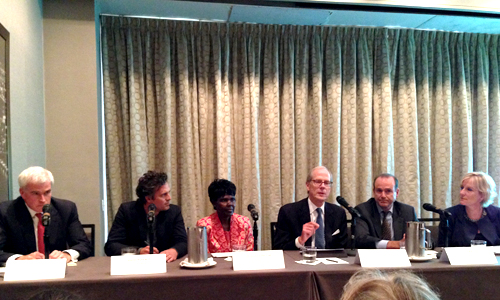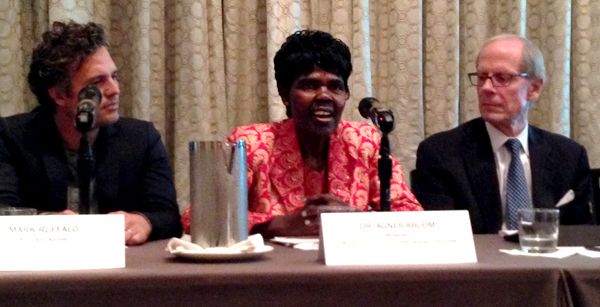

At a press conference today in New York City on the heels of yesterday’s massive People’s Climate March, the international Invest-Divest coalition announced commitments for more than $50 billion in assets that will be divested from fossil fuels and moved into clean energy to address climate change. They include scores of foundations, faith groups, health organizations and major NGOs from around the world as well as wealthy private individuals. More than 800 global investors have now committed to divest their holding in fossil fuels.
The press conference was moderated by Ellen Dorsey, the executive director of Wallace Global Fund, whose mission is to direct its money to further environmental protection. Participants included Stephen Heinz, president of the Rockfeller Brothers Fund; Agnes Aboum, principal at the World Council of Churches; David Blood, co-founder of Generation Investment, and actor Mark Ruffalo, as well as Archbishop Desmond Tutu by video.
“Climate change is the human rights challenge of our time. We can no longer continue feeding our addiction to fossil fuels as if there is no tomorrow, for there will be no tomorrow,” said Archbishop Tutu, a leading advocate of the divestment movement. He called for a freeze on all new fossil fuel exploration as the companies cannot safely burn 75 percent of known reserves.
These divestment commitments will be presented to the world leaders, including President Obama, at the UN Climate Summit tomorrow as evidence of the growing pressure to “move beyond the fossil fuel era,” as Archbishop Tutu puts it.
“John D. Rockefeller, the founder of Standard Oil, moved America out of whale oil and into petroleum,” explained Stephen Heintz, president of the Rockefeller Brothers Fund. “We are quite convinced that if he were alive today, as an astute businessman looking out to the future, he would be moving out of fossil fuels and investing in clean, renewable energy.”
“We encourage heads of state meeting at the United Nations to join with all people to take decisive steps to reverse climate change,” said Dr. Agnes Abuom, moderator of the World Council of Church’s Central Committee. “Let us move together to rebuild, restore and reclaim a life-giving and life-empowering world where all live in dignity, peace and justice.”
The Divest-Invest coalition just formed in January, but the number of commitments it’s already gotten illustrates the urgency about saving the environment felt by wealthy investors and organizations as well as the now reported 400,000 grassroots groups and ordinary citizens who attended yesterday’s march.
This morning Scott Wallace, co-chair of the Wallace Global Fund, which has coordinated the Divest-Invest effort, was on Democracy Now! He is the grandson of Henry Wallace, who served as Franklin D. Roosevelt’s vice president and ran for president in 1948 on the Progressive Party ticket. Watch the interview below:
YOU MIGHT ALSO LIKE
Divestment Goes Mainstream as Major Funds Kick the Fossil Fuel Habit
New IPCC Report: Fossil Fuel Divestment Must Start Now
NY Times Gets It Wrong With Attacks on Tom Steyer and Fossil Fuel Divestment

 233k
233k  41k
41k  Subscribe
Subscribe 

